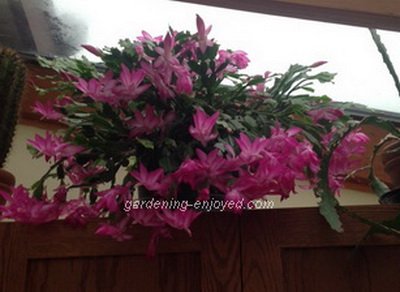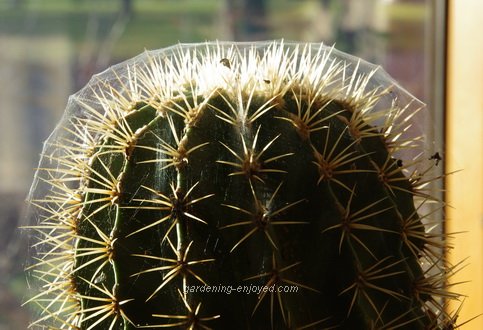| Back to Back Issues Page |
 |
|
Dallying In The Dirt, Issue #242--- These Cactus are a mass of indoor blooms. November 30, 2015 |
 Keeping with the Cactus theme, this beauty was moved down from the high solarium shelf to a place of prominence on the kitchen island. It is a Schlumbergera spp. a small Cactus genus of about six species. They are widely grown as houseplants because of their prolific flowering. I have two large plants. This one is known as the Thanksgiving Cactus for its ability to reliably bloom on the American Thanksgiving. There are a few colours in the red, pink, orange range that are available as hybrids of this species. My other plant will be along in about a month as it blooms reliably at Christmas time. Both of these plants are quite easy to grow and bloom. They are short day plants, their bloom cycle is initiated when the daylight hours are fewer than the dark hours. The number of short days to initiate flowering is obviously different for the two species. Their flowering may be inhibited by artificial light that extends their daylight hours. Mine both
live on upper shelves in the solarium where little or no artificial light ever disturbs the natural rhythms. When the days are frost free in the spring they both move outdoors to a shady location and receive a haircut on the way there. Typically I remove about 1/3 of the growth and most of that has regrown by the time they move back indoors before the first frost. They do get regular fertilizer when they are outside but almost never once they move indoors. Like most Cactus they enjoy being well watered but not often. They would be easy to kill with too much water during the winter but I know that I have neglected them for a considerable period of time with no ill effects.
Keeping with the Cactus theme, this beauty was moved down from the high solarium shelf to a place of prominence on the kitchen island. It is a Schlumbergera spp. a small Cactus genus of about six species. They are widely grown as houseplants because of their prolific flowering. I have two large plants. This one is known as the Thanksgiving Cactus for its ability to reliably bloom on the American Thanksgiving. There are a few colours in the red, pink, orange range that are available as hybrids of this species. My other plant will be along in about a month as it blooms reliably at Christmas time. Both of these plants are quite easy to grow and bloom. They are short day plants, their bloom cycle is initiated when the daylight hours are fewer than the dark hours. The number of short days to initiate flowering is obviously different for the two species. Their flowering may be inhibited by artificial light that extends their daylight hours. Mine both
live on upper shelves in the solarium where little or no artificial light ever disturbs the natural rhythms. When the days are frost free in the spring they both move outdoors to a shady location and receive a haircut on the way there. Typically I remove about 1/3 of the growth and most of that has regrown by the time they move back indoors before the first frost. They do get regular fertilizer when they are outside but almost never once they move indoors. Like most Cactus they enjoy being well watered but not often. They would be easy to kill with too much water during the winter but I know that I have neglected them for a considerable period of time with no ill effects.  I often write about the results, good and bad of my procrastination. These Geranium cuttings were placed in this propagation bed sometime in mid September and were kept regularly watered. They were well rooted enough to pot up, some time ago and it was my intention to do so, on a day when the weather was too nasty to work outside. We had a lovely long warm autumn and now I have these rather healthy but overgrown Geraniums fighting for space in that propagation bed. I did dig them up and give them individual pots after I took the picture. Several had some nice blooms on them which I removed to help them make the transition. The roots on these cuttings were amazing, some growing half way across the propagation bed. A little root pruning was necessitated but the potted plants seem to be doing very well under the lights in the basement. They will be back in bloom in a couple of weeks and their care will keep my
gardener’s soul content through some of the short dark days of winter. Actually we are now less than a month away from the shortest day and then our gardening dreams can grow with each lengthening day.
I often write about the results, good and bad of my procrastination. These Geranium cuttings were placed in this propagation bed sometime in mid September and were kept regularly watered. They were well rooted enough to pot up, some time ago and it was my intention to do so, on a day when the weather was too nasty to work outside. We had a lovely long warm autumn and now I have these rather healthy but overgrown Geraniums fighting for space in that propagation bed. I did dig them up and give them individual pots after I took the picture. Several had some nice blooms on them which I removed to help them make the transition. The roots on these cuttings were amazing, some growing half way across the propagation bed. A little root pruning was necessitated but the potted plants seem to be doing very well under the lights in the basement. They will be back in bloom in a couple of weeks and their care will keep my
gardener’s soul content through some of the short dark days of winter. Actually we are now less than a month away from the shortest day and then our gardening dreams can grow with each lengthening day. Now it’s time to answer a few of my reader’s questions. Don’t forget to check the front page of the Website for frequent short ideas for current gardening activities. Sharon Asks? I have a small fig tree purchased at the local Zehrs which thrived quite well outside all summer. However I am not sure how to care for it over the winter. Last year I brought it indoors as it quickly dropped every leaf but then kept buds with little growth. Once back outside in the warmer weather it returned to it's former self without much overall growth. Can you improve on my attempts? |
| Back to Back Issues Page |
